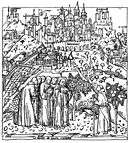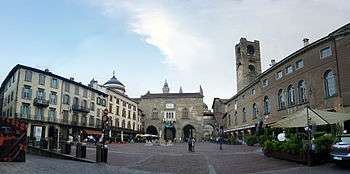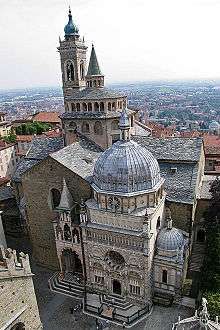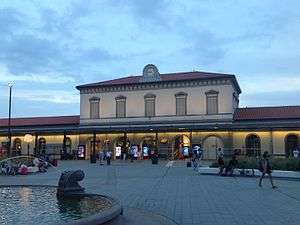Bergamo
| Bergamo | |||
|---|---|---|---|
| Comune | |||
|
Top: City skyline at sunrise. Second row. Left: Palazzo della Ragione and Bergamo Cathedral. Right: Cappella Colleoni. Third row. Left: asymptote architecture . Middle: Contarini Fountain in Piazza Vecchia. Right: Biblioteca Angelo Mai. Fourth row. Left: Bergamo–Albino light rail station. Right: Passeggiata in the central district. | |||
| |||
| Nickname(s): Città dei Mille ("City of the Thousand") | |||
 Bergamo Location of Bergamo in Italy | |||
| Coordinates: IT 45°42′N 9°40′E / 45.700°N 9.667°ECoordinates: IT 45°42′N 9°40′E / 45.700°N 9.667°E | |||
| Country | Italy | ||
| Region | Lombardy | ||
| Province | Bergamo (BG) | ||
| Government | |||
| • Mayor | Giorgio Gori (PD) | ||
| Area | |||
| • Total | 39.6 km2 (15.3 sq mi) | ||
| Elevation | 249 m (817 ft) | ||
| Population (31 December 2011) | |||
| • Total | 121,316 | ||
| • Density | 3,100/km2 (7,900/sq mi) | ||
| Demonym(s) |
Bergamasque Bergamaschi (Italian) Bergamàsch (Eastern Lombard) | ||
| Time zone | CET (UTC+1) | ||
| • Summer (DST) | CEST (UTC+2) | ||
| Postal code | 24100 | ||
| Dialing code | (+39) 035 | ||
| Patron saint | Saint Alexander | ||
| Saint day | 26 August | ||
Bergamo (Italian: [ˈbɛrɡamo] ![]() listen ; Lombard: Bèrghem,
listen ; Lombard: Bèrghem, ![]() listen ) is a city in Lombardy, Italy. It is situated about 40 km (25 mi) northeast of Milan and 30 km (19 mi) from the lakes Como and Iseo. The foothills of the Bergamo Alps begin immediately north of the town.
listen ) is a city in Lombardy, Italy. It is situated about 40 km (25 mi) northeast of Milan and 30 km (19 mi) from the lakes Como and Iseo. The foothills of the Bergamo Alps begin immediately north of the town.
Bergamo is the seat of the Province of Bergamo. With a population of around 120,000, Bergamo is the fourth-largest city in Lombardy. The metropolitan area of Bergamo extends beyond the administrative city limits, spanning over a densely urbanized area with slightly less than 500,000 inhabitants.[1]
This area is itself part of the broader Milan metropolitan area, home to over 8 million people.[2][3][4]
Bergamo is well connected to several cities in Europe and the Mediterranean through Il Caravaggio International Airport, the third-busiest airport in Italy with 10.5 million passengers in 2015, and the motorway A4 stretching on the axis between Milan, Verona, and Venice.
As of 2015, Bergamo is the second most visited city in Lombardy after Milan.[5]
History
Antiquity
Bergamo occupies the site of the ancient town of Bergomum, founded as a settlement of the Celtic tribe of Cenomani. In 49 BC it became a Roman municipality, containing c. 10,000 inhabitants at its peak. An important hub on the military road between Friuli and Raetia, it was destroyed by Attila in the 5th century.
Middle Ages

From the 6th century Bergamo was the seat of one of the most important Lombard duchies of northern Italy, together with Brescia, Trento, and Cividale del Friuli: its first Lombard duke was Wallaris. After the conquest of the Lombard Kingdom by Charlemagne, it became the seat of a county under one Auteramus (d. 816). An important Lombardic hoard dating from the 6th to 7th centuries AD was found in the vicinity of the city in the nineteenth century and is now in the British Museum.[6]
From the 11th century onwards, Bergamo was an independent commune, taking part in the Lombard League which defeated Frederick I Barbarossa in 1165. The local Guelph and Ghibelline factions were the Colleoni and Suardi, respectively. Feuding between the two initially caused the family of Omodeo Tasso to flee north c. 1250, but he returned to Bergamo in the later 13th century to organize the city's couriers: this would eventually lead to the Imperial Thurn und Taxis dynasty generally credited with organizing the first modern postal service. From 1264, Bergamo was intermittently under the rule of Milan. In 1331, it gave itself to John of Bohemia, but the Milanese Visconti reconquered it.
Early modern
After a short conquest by the Malatesta in 1407, in 1428 it fell under the control of the Venetian Republic, remaining part of it until 1797. Between 1797 and 1815, Bergamo and its territory were included in the political entities born in North Italy during the French and Napoleonic dominion. Notably, the Venetians fortified the higher portion of the town (see Main sights section).
Late modern and contemporary
In 1815, it was assigned to the Austrian Empire. Giuseppe Garibaldi freed it in 1859 during the Second Italian War of Independence, when Bergamo became part of the Kingdom of Italy. For its contribution to "Il Risorgimento" the city is also known as "Città dei Mille" ("City of the Thousand"). During the 20th century Bergamo became one of Italy's most industrialized cities. It is also one of the few Italian cities that did not suffer major destruction during World War II.
Geography
Climate
Bergamo experiences a humid subtropical climate (Köppen climate classification Cfa) characteristic of Northern Italy. While most of Italy is characterized by dry summers with little to no precipitation, Bergamo has the reverse trend; the summer is wetter than winter. However, Bergamo's climate is designated with an f because there is statistically significant rainfall throughout the winter (in order to qualify for a w precipitation designation under the Köppen scale, the driest month in the winter would need to have less than 12.95 mm (1 in).)
| Climate data for Bergamo (1971–2000, extremes 1946–present) | |||||||||||||
|---|---|---|---|---|---|---|---|---|---|---|---|---|---|
| Month | Jan | Feb | Mar | Apr | May | Jun | Jul | Aug | Sep | Oct | Nov | Dec | Year |
| Record high °C (°F) | 21.9 (71.4) |
22.7 (72.9) |
27.1 (80.8) |
31.9 (89.4) |
35.5 (95.9) |
36.3 (97.3) |
39.0 (102.2) |
37.9 (100.2) |
32.4 (90.3) |
29.0 (84.2) |
23.0 (73.4) |
19.0 (66.2) |
39.0 (102.2) |
| Average high °C (°F) | 6.6 (43.9) |
8.6 (47.5) |
13.0 (55.4) |
16.4 (61.5) |
21.4 (70.5) |
25.3 (77.5) |
28.3 (82.9) |
27.8 (82) |
23.4 (74.1) |
17.6 (63.7) |
11.1 (52) |
7.2 (45) |
17.2 (63) |
| Daily mean °C (°F) | 2.7 (36.9) |
4.4 (39.9) |
8.2 (46.8) |
11.4 (52.5) |
16.2 (61.2) |
19.9 (67.8) |
22.8 (73) |
22.6 (72.7) |
18.6 (65.5) |
13.3 (55.9) |
7.3 (45.1) |
3.4 (38.1) |
12.6 (54.7) |
| Average low °C (°F) | −1.1 (30) |
0.1 (32.2) |
3.3 (37.9) |
6.3 (43.3) |
11.0 (51.8) |
14.5 (58.1) |
17.3 (63.1) |
17.3 (63.1) |
13.8 (56.8) |
9.0 (48.2) |
3.4 (38.1) |
−0.3 (31.5) |
7.9 (46.2) |
| Record low °C (°F) | −15.0 (5) |
−20.1 (−4.2) |
−7.7 (18.1) |
−3.6 (25.5) |
1.7 (35.1) |
4.2 (39.6) |
8.9 (48) |
8.4 (47.1) |
5.1 (41.2) |
−1.7 (28.9) |
−7.0 (19.4) |
−12.4 (9.7) |
−20.1 (−4.2) |
| Average precipitation mm (inches) | 66.1 (2.602) |
54.0 (2.126) |
71.5 (2.815) |
87.4 (3.441) |
122.5 (4.823) |
121.2 (4.772) |
91.9 (3.618) |
100.3 (3.949) |
114.3 (4.5) |
121.5 (4.783) |
87.5 (3.445) |
64.4 (2.535) |
1,102.6 (43.409) |
| Average precipitation days (≥ 1.0 mm) | 7.1 | 5.3 | 7.0 | 9.3 | 11.1 | 9.1 | 6.3 | 7.2 | 6.5 | 8.3 | 7.1 | 6.6 | 90.9 |
| Average relative humidity (%) | 75 | 75 | 68 | 71 | 69 | 67 | 67 | 68 | 71 | 75 | 78 | 79 | 72 |
| Source: Servizio Meteorologico (humidity 1961–1990)[7][8][9] | |||||||||||||
Cityscape

The town has two centres: "Città alta" (upper city), a hilltop medieval town, surrounded by 16th-century cyclopic defensive walls, and the "Città bassa" (lower city). The two parts of the town are connected by funicular/cable car, roads, and foot-paths. Parking spaces are very limited in the upper city.
Upper city

The upper city, surrounded by Venetian walls built in the 16th century, forms the historic centre of Bergamo.[10] Città Alta is an extremely expensive place to live in, with properties being sold for five to twelve thousand euro per square meter. This has numerous places of interest including:
- Cittadella (Citadel), built by the Visconti in the mid-14th century.
- Piazza Vecchia (old square)
- Palazzo della Ragione. This was the seat of the administration of the city in the age of the communes. Currently it houses a selection of paintings from the Accademia Carrara. Erected in the 12th century, it was rebuilt in the late 16th century by Pietro Isabello. The façade has the lion of St. Mark over a mullioned window, testifying to the long period of Venetian dominance. The atrium has a well-preserved 18th-century sundial.
- Palazzo Nuovo (Biblioteca Angelo Mai). It was designed by Vincenzo Scamozzi in the early 17th century but only completed in 1928.
- Basilica di Santa Maria Maggiore (Saint Mary Major). It was built from 1137 on the site of a previous religious edifice of the 7th century. Construction continued until the 15th century. Of this first building the external Romanesque structure and the Greek cross plan remain. The interior was extensively modified in the 16th and 17th centuries. The dome has frescoes by Giovanbattista Tiepolo. Noteworthy are the great Crucifix and the tomb of Gaetano Donizetti.
- Cappella Colleoni (Colleoni chapel), annexed to Santa Maria Maggiore, is a masterwork of Renaissance architecture and decorative art. It contains the tomb of the condottiere Bartolomeo Colleoni.
- The Battistero (Baptistry), an elegant octagonal building dating from 1340.
- Bergamo Cathedral (Duomo). This was built in the late 17th century with later modifications.
- Rocca (Castle). It was begun in 1331 on the hill of Sant'Eufemia by William of Castelbarco, vicar of John of Bohemia, and later completed by Azzone Visconti. A wider citadel was added, but is now partly lost. The Venetians built a large tower in the Rocca, as well as a line of walls (Mura Veneziane) 6,200 metres long.
- San Michele al Pozzo Bianco. Built in the 12th century, this church contains a wealth of frescos from the 12th to the 16th centuries, including paintings by Lorenzo Lotto.
- Museo Civico Archeologico (Archaeological Civic Museum) This is housed in the Cittadella.
- Museo di Scienze Naturali Enrico Caffi (Caffi Natural Science Museum) This is also housed in the Cittadella.
- Orto Botanico di Bergamo "Lorenzo Rota" (botanical garden).
- Città Alta and its surroundings are part of the Parco dei Colli di Bergamo
-

Torre Civica
-

Citadel
-

Via Gombito
-
San Vigilio Castle
-
Palazzo Medolago
-

Porta San Giacomo
Lower city
The lower city is the modern centre of Bergamo. At the end of the 19th century Città Bassa was composed of residential neighborhoods built along the main roads that linked Bergamo to the other cities of Lombardy. The main boroughs were Borgo Palazzo along the road to Brescia, Borgo San Leonardo along the road to Milan and Borgo Santa Caterina along the road to Valle Seriana. The city rapidly expanded during the 20th century. In the first decades, the municipality erected major buildings like the new courthouse and various administrative offices in the lower part of Bergamo in order to create a new center of the city. After World War II many residential buildings were constructed in the lower part of the city which are now divided into several neighborhoods such as Longuelo, Colognola, Malpensata and Boccaleone, Redona and Valtesse among many others. The shopping district developed shortly after, now commonly known as the street the shops are located on Via 20 Settembre. The church "Santo Spirito" exhibits the altarpiece by Lorenzo Lotto "Madonna and Child with Saints". The most relevant sites are:
- Pinacoteca dell'Accademia Carrara
- Galleria d'Arte Moderna e Contemporanea (Gallery of Modern and Contemporary Art), known as GAMeC.
-

Santa Maria delle Grazie
-
Torre dei Caduti
-

Accademia Carrara
-

Bergamo by night
Demographics
In 2010, there were 119,551 people residing in Bergamo (in which the greater area has about 500 000 inhabitants), located in the province of Bergamo, Lombardia, of whom 46.6% were male and 53.4% were female. Minors (children ages 18 and younger) totalled 16.79 percent of the population compared to pensioners who number 23.61 percent. This compares with the Italian average of 17.88 percent (minors) and 20.29 percent (pensioners). The average age of Bergamo residents is 45 compared to the Italian average of 43. In the eight years between 2002 and 2010, the population of Bergamo grew by 5.41 percent, while Italy as a whole grew by 5.77 percent.[11] The current birth rate of Bergamo is 8.4 births per 1,000 inhabitants compared to the Italian average of 9.3 births.
In 2010, 85% of the population was Italian. The largest immigrant group comes from other European nations (the largest being Romania and Ukraine): 4.89%, Americas (mostly from Cochabamba, Bolivia): 4.61%, sub-saharan Africa: 1.59%, and North Africa: 1.53%. Currently one-fifth of the babies born in Bergamo has at least one foreign parent. The city is predominantly Roman Catholic and also host the see of a Diocese of Bergamo, but due to immigration now has some Orthodox Christian, Muslim, and Protestant adherents.
Economy
As capital and main town of its province, Bergamo hosts the public administration offices of provincial interest. In the past, many factories were in the commune territory, mainly for electrical components, industrial mechanics and publishing businesses, but have then moved outward. In the town three large corporations are still based:
- Italcementi SpA, general headquarters of the 5th largest cement producer in the world.
- UBI group, ex BPU e Banca Popolare di Bergamo - Credito Varesino, general headquarters of the 4th largest Italian bank group.
- Brembo, general headquarters and plants of the manufacturer of automotive brake systems' leader, especially for high-performance cars and motorcycles.
- Tenaris, is a global manufacturer and supplier of seamless and welded steel pipe products and provider of pipe handling, stocking and distribution services to the oil and gas, energy and mechanical industries.
- ABB SpA, offices and plants of a multinational corporation operating mainly in the power and automation technology areas.
Culture
Music

Bergamo has a prominent place in music history. The large Romanesque church of Santa Maria Maggiore, begun in 1137, had a continuous and well-documented tradition of music teaching and singing for more than eight hundred years. When the town was under Venetian control, the musical style of the Venetians was imported as well; in particular, a large instrumental ensemble grew up to support the choral singing. Composers such as Gasparo Alberti produced music with polyphony using two organs, brass and viols, a style usually associated with Venice, but which flourished in the fine acoustic environment of Santa Maria Maggiore.
The city lent its name to a style of folk dance known as bergamask peculiar to the peoples of that region. Known as bergomasci and renowned for their buffoonery, the fool Bottom in Shakespeare's A Midsummer's Night's Dream refers to their Bergomask dance. This unconventional form gave Debussy a vehicle for the dissonances and irregular intervals of his "Suite bergamasque".
Prominent musicians born in Bergamo include Gaetano Donizetti, Pietro Locatelli, Antonio Lolli, Gianluigi Trovesi, Roby Facchinetti, Alfredo Piatti, Fabrizio Frigeni and Gianandrea Gavazzeni. Alessandro Grandi, one of the most progressive composers of the early 17th century after Monteverdi, was maestro di cappella there until his death in the plague of 1630; Tarquinio Merula, an even more progressive composer, and one of the founders of the early sonata, took over his post.
Notable natives
Bergamo was the hometown and last resting place of Enrico Rastelli, a highly technical and world famous juggler who lived in the town and, in 1931, died there at the early age of 34. There is a life-sized statue to Rastelli within his mausoleum. A number of painters were active in the town as well; among these were Giovanni Paolo Cavagna, Francesco Zucco, and Enea Salmeggia, each of whom painted works for the church of Santa Maria Maggiore. Sculptor Giacomo Manzù and the bass-baritone opera singer Alex Esposito[12] were born in Bergamo. The famous American electrical engineer and professor Andrew Viterbi, inventor of the important Viterbi's algorithm, was born in Bergamo, before migrating in USA during the fascism because of his Jewish origin. Designers born in Bergamo include the late Mariuccia Mandelli, the founder of Krizia and one of the first female fashion designers to create a successful line of men's wear.[13]
Sports
- Bergamo's football team is Atalanta who play in the top level Serie A at the Stadio Atleti Azzurri d'Italia
- The town has a woman's volleyball team named Foppapedretti Bergamo.
- The city is also home to the Bergamo Lions American football team, one of the most successful in European Football League history, winning multiple Eurobowls.
Education
Transport


Airport
Bergamo is served by Il Caravaggio International Airport, located 5 km (3 mi) south-east of the town, which is the third busiest airport in Italy, serving 10.404.625 million passengers in 2015. The city is also served by Milan Linate Airport, located 50 km (31 mi) south-west of Bergamo.
Motorway
Motorway A4 is the main axis connecting the city with the east and the west of the country, to cities such as Milan, Turin, Venice and Trieste.
Railway
Bergamo railway station is connected with the rest of Lombardy by trains for Milan, Lecco, Cremona, Treviglio, Brescia and Monza. Railway service is operated by Trenord and TiLo.
Urban transport
Transport within Bergamo is managed by ATB and includes a network of bus lines together with two funicular systems opened in 1887 (Funicolare di Bergamo Alta) and in 1912 (Funicolare di Bergamo-San Vigilio). The Bergamo–Albino light rail was inaugurated in 2009. Three light rail lines are currently in planning stage:
- Line 1 Bergamo FS - Albino
- Line 2 Bergamo FS - Villa d'Almè - San Pellegrino Terme
- Line 3 Hospital-Railway Station FS-Trade Fair - Bergamo Airport.
International relations
Twin towns − sister cities
Bergamo has a partnership with:
 Dąbrowa Górnicza, Poland[14]
Dąbrowa Górnicza, Poland[14] Olkusz, Poland[14]
Olkusz, Poland[14] Bolesław, Poland[14]
Bolesław, Poland[14] Posadas, Argentina, as Friendship and Cooperation city since 1998[17]
Posadas, Argentina, as Friendship and Cooperation city since 1998[17]
Consulates
Bergamo is home to the following consulates:
See also
References
- ↑ "Urbanismi in Italia, 2011" (PDF). cityrailways.it (in Italian). Retrieved 4 November 2014.
- ↑ OECD Territorial Review - Milan, Italy
- ↑ http://urbact.eu/fileadmin/subsites/Metrogov/pdf/Milan_s2.pdf Competitiveness of Milan and its metropolitan area
- ↑ ISTAT
- ↑ "RSY Lombardia-Arrivals and nights spent by guests in accommodation establishments, by type of resort and by type of establishment. Total accommodation establishments. Part III. Tourist resort. Year 2012". asr-lombardia.it. Retrieved 4 November 2014.
- ↑ British Museum Collection
- ↑ "Bergamo/Orio Al Serio (BG)" (PDF). Atlante climatico. Servizio Meteorologico. Retrieved March 6, 2015.
- ↑ "STAZIONE 076 Bergamo Orio Al Serio: medie mensili periodo 61 - 90". Servizio Meteorologico. Retrieved March 6, 2015.
- ↑ "Bergamo Orio al Serio: Record mensili dal 1946" (in Italian). Servizio Meteorologico dell’Aeronautica Militare. Retrieved March 6, 2015.
- ↑ "The city of Bergamo". UNESCO World Heritage Centre. Retrieved 1 February 2015.
- ↑ "Statistiche demografiche ISTAT". Demo.istat.it. Retrieved 15 April 2012.
- ↑ "Alex Esposito". www.roh.org.uk. Royal Opera House. Retrieved 25 February 2014.
- ↑ Fox, Margalit (2015-12-07). "Mariuccia Mandelli, Italian Fashion Designer, Dies at 90". New York Times. Retrieved 2016-01-04.
- 1 2 3 4 5 6 7 8 9 "Gemellaggi e relazioni internazionali" (official website) (in Italian). Comune di Bergamo. 7 April 2006. Retrieved 2015-03-28.
- ↑ "Pueblo's Sister Cities Home" (official website). Pueblo, CO, USA: Pueblo Sister Cities Commission. Retrieved 2015-03-28.
- ↑ "Convenios Internacionales" (official website) (in Spanish). Cochabamba, Bolivia: Gobierno Autónomo Municipal de Cochabamba. Retrieved 2015-03-28.
- ↑ "Posadas y sus hermanas" (in Spanish). Primera Edición. Retrieved 2015-03-28.
- ↑ Consolato Onorario della BOLIVIA "Easydiplomacy
- ↑ Consolato Onorario del Malawi a Bergamo > Company Profile | Guida Monaci
- ↑ Rappresentanze svizzere
Further reading
- Published in the 19th century
- "Bergamo", Hand-book for Travellers in Northern Italy (16th ed.), London: John Murray, 1897, OCLC 2231483
- Published in the 20th century
- Edward Hutton (1912), "Bergamo", The Cities of Lombardy, New York: Macmillan Co.
- "Bergamo", Northern Italy (14th ed.), Leipzig: Karl Baedeker, 1913
- Egerton R. Williams Jr. (1914), "Bergamo (etc.)", Lombard Towns of Italy, London: Smith, Elder & Co.
External links
| Wikivoyage has a travel guide for Bergamo. |
| Wikimedia Commons has media related to Bergamo. |
| ||||||||||||||||||||||
| ||||||||||||||
| ||||||||||||||||||||||
|



